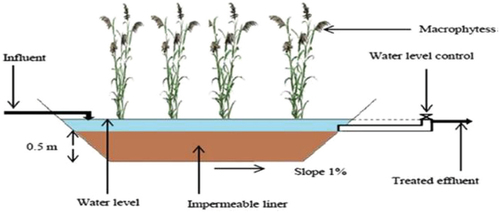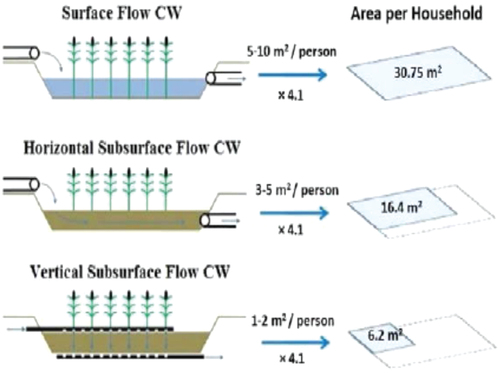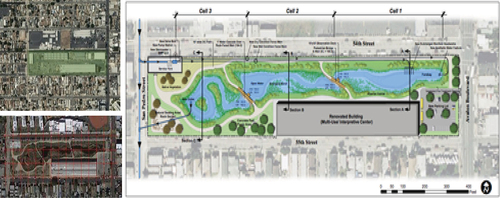ABSTRACT
Cities worldwide face resilience challenges as climate risks interact with rapid urbanization, loss of biodiversity and ecosystem services, poverty, and Socioeconomic inequality. This leads to the social, physical, and economic collapse of cities and their systems. Over time, urban resilience challenges are expected to increase, driven by urbanization, land use, and climate change. It is for this reason that the concept of urban resilience is increasingly attracting the attention of governments, and urban planners. Gray infrastructure is not always suitable for profitability, resilience, or sustainability. Now more than ever, green infrastructure is recognized as a nature-based solution (NBS) that plays a significant role in addressing resilience challenges in urban areas. These solutions can be applied through spatial measurements and parameters in and around the city. Constructed wetlands (Cws) are artificial imitations of natural wetlands, one of the most biologically diverse natural ecosystems, and in addition to aesthetics, It provides an effective model for resilient environmental engineering solutions as a low-cost and easy-to-operate alternative to traditional urban management systems. Consequently, the main objective of this research was to define criteria for integrating constructed wetlands (Cws) into the urban landscape as nature-based solutions (NBS) and address the limitations and maximize advantages as well as contribute to replicate best practices of constructed wetlands (Cws) in different Zones (Desert, River’s floodplain, coastal) in Egyptian cities for enhancing the urban resilience.
Introduction
This research covers – two major parts; first of which prove a theoretical framework through literature review examining the notion of urban resilience, comprehensive approach to resilience, characteristics of a Resilient System, as well as the role of infrastructure in enhancing resilience. Subsequently, studying nature-based solutions (NBS) as resilient systems and their potential in facing urban resilience challenges. Like that the concept, benefits, and forms of constructed Wetlands (Cws) say the correlation between them as flexible, nature-based, and multifunctional solutions capable of responding to various urban risks and pressures.
The second part of the study applies an analytical approach, through reviewing and analyzing different experiences of constructed wetlands (Cws) projects that incorporates the concept of urban resilience city that faces major challenges and hazards. Furthermore, pointing the role that constructed that wetlands could play as a flexible solution to the high-profile climate change risks facing Egyptian cities.
The paper strives to define criteria to integrate constructed wetlands (Cws) as nature-based solutions into the urban landscape to enhance urban resilience in cities. This meant to address the limitations and maximize advantages as well as contribute to replicate best practices of constructed wetlands to prominent resilience challenges hazards facing Egyptian cities, and thus enhance urban resilience in different Zones (Desert, River’s floodplain, coastal) in Egyptian cities by producing clear findings and recommendations.
Urban resilience definition
Over the earliest years, resilience definitions have proliferated according to different fields and perspectives. Theorists have contributed to the definition of resilience. In the 1970s, the ‘resilience’ appeared as an ecological term to express the system’s ability to cope with change and preserve and improve its function in case of disturbance. Resilience is therefore defined as the ability of systems to resist, adapt to, and recover from the impact of risks quickly and effectively. Later, the term was applied to cities due to the complexity of the system, which is constantly facing changing conditions [Citation1], and the concept of ‘urban resilience’ quickly gained attention as a key place for research in urban studies.
At the urban scale, the meaning of resilience in the context of cities concentrated on understanding the disaster risks it can face, mitigate, and respond to potential disasters that can occur to minimize the long-term losses, damage of property, infrastructure, economic activities, and the environment. Adding to how rebound from these shocks and chronic pressures [Citation2].
Comprehensive approach to resilience
The comprehensive approach to resilience put forward by the Asian Development Bank (ADB) includes four main dimensions: physical, financial, ecological and society resilience, see . This aims to build resilience to climate change and natural disasters to achieve the 2030 Strategy priority of strengthening disaster and climate resilience while promoting prosperous, inclusive development comprehensive and sustainable, through achieving different priorities [Citation3].
Figure 1. The comprehensive approach to resilience.
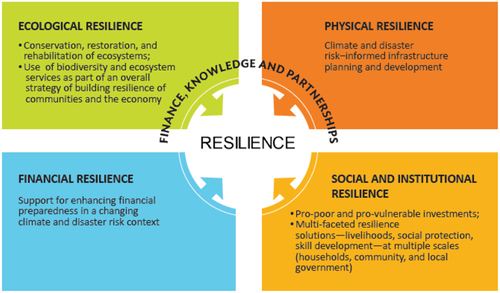
First (Physical Resilience): Climate change and natural disaster risks must be considered when planning, designing, and constructing infrastructure projects.
Second, (Ecological resilience): More attention needs to be paid to biodiversity and ecosystem services.
Third (Social Resilience): Emphasis should be placed on the human and social dimensions of climate and disaster resilience. In particular, the disproportionate impact of climate change and natural disasters on poor and vulnerable populations.
Finally (financial resilience): Economic management of residual disaster risks must be strong and effective and must support rapid relief and early recovery efforts and rebuild to build back better [Citation3].
The growing interest in green infrastructure (GI)
Historically, structural interventions to reduce disaster risk have focused on gray infrastructure which refers to build structures and mechanical equipment as containers, earthwork, pipes, pumps, water treatment plants, and canals. These solutions are embedded within watersheds or coastal ecosystems whose hydrological and environmental attributes profoundly affect the performance of the gray infrastructure. Although, this is not always proper in terms of profitability, resilience, or sustainability, there is a need to promote green infrastructure (nature-based solutions) which is a general term referring to ‘actions to protect, sustainably manage, and restore natural or modified ecosystems that addressing societal challenges effectively and adaptively, concomitantly providing human well-being and biodiversity benefits’. Which endorsed by various international agreements and initiatives to support the alignment of environmental and risk management goals [Citation4].
Definition of natural based solutions (NBS)
The European Union has defined (NBS) as ‘actions inspired, supported or copied from nature’ [Citation5]. These solutions are approaches that use nature and natural processes to deliver integrated infrastructure, services, and solutions to address the growing challenge of urban resilience. The concept of (NBS) appeared in the early 2000s to promote nature in addressing the challenges associated with climate change. Several factors have fueled the increasing interest in (NBS) as [Citation6]:
Brings numerous benefits to cities and addresses various social challenges.
Reducing natural disaster risks and recognizing the impacts of climate change.
Contribute to the restoration of biodiversity.
Create recreational opportunities, improve human health, water and food security, and support community wellbeing and livelihoods.
Design for resilience using nature-based solutions (NBS)
NBS is widely seen as a new tool and asset class to address climate and disaster risks, and as a tool to build resilience. Which characterized by the seven attributes of resilience systems named by the City Resilience Framework [Citation7]. They are: (Reflective, Robust, Flexible. Redundant, Integrated, Inclusive, Resourceful suggests how NBS interacts with and supports these seven characters, see .
Figure 2. Resilient system qualities and contributions of nature-based solutions. Source: Author, adapted from Arup. 2014. City resilience framework. City resilience index. New York: the Rockefeller foundation https://www.arup.com/perspectives/publications/research/section/city-resilience-index.
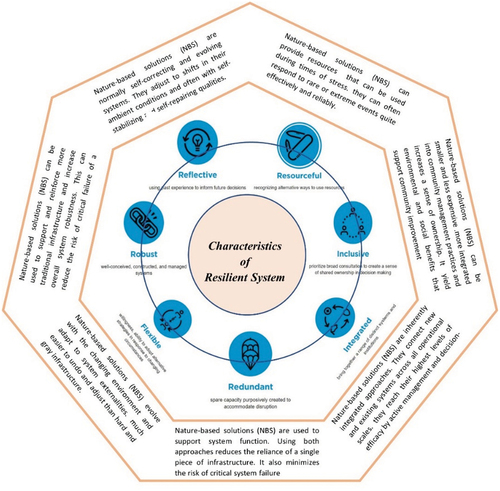
Nature-based solutions (NBS) for urban regeneration can be applied at all scales and spatial contexts, in and around cities. Examples include small-scale green spaces on buildings, biological systems and green corridors along streets and water bodies, urban parks, and forests within city limits. Constructed wetlands (Cws) are an effective example of flexible eco-engineering solutions as a low-cost, easy-to-operate alternative to traditional urban management systems. It is used to resist natural disasters, support the stability of the urban ecosystem, and provide a safer, more suitable space for biological habitat and human activities.
Wetlands system
Wetlands are defined as land where the water surface is close to the ground. The definitions approved by the Ramsar Convention are: “A swamp, bog, peatland, or water areas, whether natural or human-caused, permanent, or temporary, having stood or flowing water, fresh, brackish, or salt water, marine’s whose depth does not exceed six meters. Which may include coastal and coastal areas next to wetlands, islands, or seawater that are more than six meters deep at low tide and within wetlands [Citation8].
Constructed wetlands system (cws)
Systems designed for constructed wetlands (Cws), like natural wetlands, are designed to take advantage of natural processes associated with wetland vegetation, soil, and other assemble their associated microorganisms to aid in water treatment and supply other added functions to the water [Citation9].
Techniques for constructed wetlands
Constructed wetlands (Cws) vary in size and appearance as do water flows. By using two types of water flow: surface water flow or groundwater flow depending on numerous factors such as needed water flow or other aesthetic or landscape factors, see .
Surface constructed wetlands
The open water system simulates a natural wetland ecosystem where plants filter the water. Wetland plants are wonderful natural assets; and water purification see ., this system supports a significant degree of biodiversity [Citation10].
Subsurface gravel wetlands
These systems treat contaminated water by slowly pumping it through underground gravel layers where water is filtered through the root zone and soil in a vertical or horizontal attitude flow model, see [Citation10].
Constructed wetlands (Cws)achieving a comprehensive approach to resilience
Constructed wetlands (Cws) supply a set of functions covering the four dimensions of the comprehensive approach to building resilience to disasters and climate change (environmental, physical, social, and financial resilience) see .
Figure 5. Catalogue of constructed wetlands (CWS) for Urban Resilience. Source: adapted from X. Lu. 2019. Building resilient infrastructure for the future: background paper for the G20 climate sustainability working group. ADB sustainable development working paper series. No. 61. Manila: Asian development Bank.

Physical resilience (risks and natural disasters)
Constructed wetlands (Cws) contribute to plan and develop infrastructure aware of climate and disaster risks, they can supply resilience to the following natural hazards:
Floods: Constructed wetlands (Cws) in floodplains along water courses are used as temporary water reservoirs to mitigate the effects of floods by absorbing excess water and keeping or returning it to the aquifer.
Drought: constructed wetlands (Cws) can store water to create a buffer against drought.
Fires: artificial wetlands can function as a natural barrier to the spread of fires, regulating their frequency and intensity.
Hurricanes: coastal salt marshes help mitigate the impact of storms by slowing the speed and reducing the height and force of waves, slowing winds, and stabilizing soil and sediment.
Landslides and erosion: artificial wetlands reduce the risk of river basin and riverbank erosion.
They provide natural flood storage, distribute flood flows, and reduce impacts to downstream areas.
Heat stress risk: Constructed wetlands (Cws) can help reduce the heat island effect in urban areas and supply cooling to surrounding areas, which is especially suitable in urban environments where heat stress is more severe [Citation11].
Ecological resilience
Constructed wetlands (Cws) are being improved to conserve and restore ecosystems, see .
Figure 6. Benefits of constructed wetlands for managing climate and disaster risks. Source: World Bank, 2021. A catalogue of nature-based solutions for urban resilience. Washington, D.C. World Bank group.
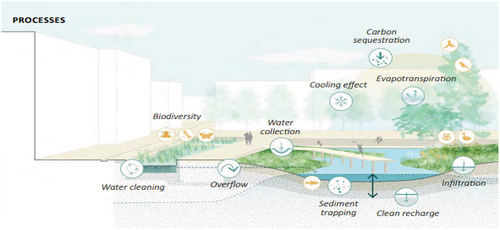
Habitat and biodiversity enhancement: Varied species find suitable habitats in the constructed wetlands, contributing to the creation of healthy, multi-functional landscapes. The values of biodiversity can be enhanced by introducing islands and creating areas of varying water depth, which positively reflected in the character and identity of the urban environment [Citation12].
Water quality and sediment quality management: constructed wetlands are efficiently treating wastewater resulting from rainwater runoff or agricultural or municipal discharges. It often required regular maintenance to increase the efficiency of the system.
Carbon storage and sequestration: constructed wetlands play a significant role in carbon sequestration. However, performance depends on design, as they must be effectively managed and designed, so as not to become a source of greenhouse gases [Citation13].
Social resilience
Constructed Wetlands (Cws) supply multifunctional solutions on multiple levels; they supply aesthetic and sensory experiences for urban communities:
Quality of life: From an aesthetic standpoint, constructed wetland urban landscapes play a unique role in enhancing community quality of life and people’s well-being as well as creating opportunities association for recreational and outdoor activities.
Health, physical and psychological benefits: In the urban context, constructed wetlands are improving water and air quality which support physical health, improve mental health, increase sense of happiness. and reduce crime rates [Citation14].
Institutional and financial resilience
Constructed Wetlands (Cws) are financial resilience solutions on multiple levels, due to simple configuration, less energy consumption, lower labor costs and more oriented toward poor and marginalized communities than traditional infrastructure:
Stimulate the local economy as many other jobs could be available: Constructed wetlands have significant tourism potential, which can stimulate the local economy by creating jobs [Citation15].
Resource production: Constructed wetlands (Cws) are an important source of food and construction materials. These uses must be carefully managed so as not to undermine other ecological functions, which require a balance between agricultural uses and biodiversity needs [Citation16].
Defects of constructed wetlands (Cws) and how to overcome
Constructed wetlands (Cws) are seen as resilient, nature-based solutions, however, a range of main disadvantages is:
Surface-constructed wetlands require a large area of the earth’s surface, and this can be overcome by using the Subsurface gravel wetland system, especially the vertical ones (VSF), as it requires less surface area see .
Increasing water loss through evaporation, especially in hot areas, so it is preferable to use Subsurface gravel wetlands because of their small size and therefore low evaporation rates. Waterwheels can be used in Surface constructed wetland systems to move the surface of water and then reduce evaporation rates.
They are considered potential mosquito breeding sites and can be treated by maximizing large invertebrate predators in the system [Citation17].
The surface of the open water contributes to odor emissions and can be overcome by using odor-absorbing trees such as mangroves.
Biomass management of productive plants is a concern, as increased plant biomass density affects the hydraulic efficiency of the system and threatens plant health. The biomass must be harvested above ground, and biomass can be reused to produce fertilizer and biofuels.
High transpiration rate in hot climatic areas, therefore, requires a proper study of the available native plant species used in Constructed wetlands (Cws) to figure out their water demand. Plant species choice should be considered to reduce evaporation rate to keep water balance in these systems.
Constructed wetlands (Cws) case studies as resilient solutions to address urban risks
In recent years, various constructed wetland (Cws) projects have highlighted the resilient role of artificial wetlands in the face of climatic, urban, social, and economic challenges, which will be illustrated in the following section.
The case studies selecting criteria
Wetland creation/restoration
Multifunctional Parks
Different Zones (Desert, River’s floodplain, coastal)
Various Scale wetlands (Large-scale, Medium-scale and Small-scale wetlands)
Case 1: Wadi Hanifah Wetlands Park (large-scale parks)
Location: Riyadh, Saudi Arabia, 2010 - Zone: Arid, Hot desert
Wadi Hanifah is the longest and most important valley near Riyadh in central Saudi Arabia’s desert region of Najd. The valley is a natural water drainage system for an area of 4,000 square kilometers, and it is fed by multiple streams. This continuous flow of water and treated wastewater has created a unique natural phenomenon among the arid lands, which creates an artificial wetland a hundred kilometers long with small waterfalls, lakes, and islands, supporting a rich variety of plants and animal, see [Citation18].
Figure 8. Zones make up the Wadi hanifah project. Source: https://www.landscapeperformance.org/case-study-briefs/wadi-hanifah.

Urban resilience challenge
Parts of Wadi Hanifah, particularly those near Riyadh, were used in an aggressive and environmentally harmful manner until recently. Different areas of the valley were used as garbage dumps. And a sizable part of the valley was damaged and polluted.
Quarrying and sand mining for concrete production have left scars in many places in the valley.
Good agricultural land is encroached by industrial and urban development.
The natural flow of water impeded in several areas, resulting in stagnant pools and swamp-like situations [Citation18].
Project concept
To solve the site issues, A developed plan to create urban green infrastructure a mid of the dry, arid land through a series of strategies including see :
Implementation and adoption of national wetland policies
Rehabilitation of land uses and activities of the valley.
Combining economic growth with environmental conservation
Supply an environmentally sustainable approach.
Water demand management [Citation19].
Resilience project outcomes
Physical outcome:
Mitigation of the wares of climate change
Surround existing natural wetlands to preserve natural ecosystems.
Conservation of water resources.
Ecological outcome:
Arabian wetlands conservation strategy and biodiversity preservation
Supplying water treatment while creating unique open Green Space for Public Recreation
Re-naturalization with indigenous species of shading trees, ornamental shrubs.
Enriching the environment with diverse indigenous habitat of various fauna.
Using natural stones and local materials
Social outcome:
Restore the social, cultural, and recreational importance of the wadi to the people of Riyadh.
Supplying a few aesthetic and recreational values through offering unique and interactive experiences and through designing various thematic zones that encourage visitors to experience the various activities.
Developing a major part of the park to get public participation by Respecting cultural and social values in the park’s design and offering family compartments, and semi enclosed areas that respect users’ privacy.
Financial outcome:
Reduce economic hardship at the community level.
Using The network of ponds as a water sponge for Saving of a great cost value through utilizing water sources instead of desalinization [Citation20].
Case 2: Weiliu Wetland Park (medium-scale parks)
Location: Xianyang, China,2017 – Zone: River’s floodplain
Weiliu Wetland Park was built on a stretch of the Wei River floodplain outside Xianyang city, which was flooded due to urbanization. The park is approximately 3200 m long and 470 m wide, with a total area of 1504 square kilometers see [Citation21].
Figure 9. Wadi hanifah existing situation (bioremediation site, restoring natural landscape, open-space attraction, family booths and semi-enclosed sections). Source: https://www.landscapeperformance.org/case-study-briefs/wadi-hanifa.
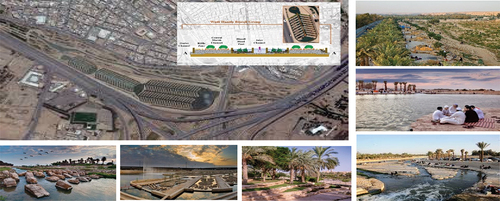
Urban resilience challenge
The project site had numerous significant issues:
The natural floodplain of the Vi River right upstream is replaced by an artificial concrete bank.
Water pollution and riverside water environment due to ditches dug across the area transporting rainwater and wastewater leaking from the city into the river.
Loss of local habitat and biodiversity following rapid urbanization in downstream neighborhoods.
Ecological degradation
Gradual loss of rural landscape [Citation22].
Project concept
To address site issues, the complete restoration and reconstruction of the local floodplain ecosystem is the primary goal of the project. A plan is developed through a series of inclusive strategies, see :
Figure 10. Weiliu Wetland Park site location, existing conditions upstream and downstream (layout & zones). Source: https://landezine.com/weiliu-wetland-park-by-yifang-ecoscape.
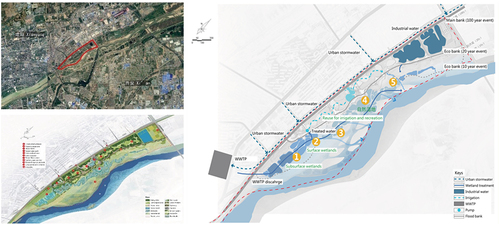
Adaptive flood control and Stormwater management
preserve the existing natural wetland.
Improving water quality
Reuse wastewater
Restore biodiversity, turning this area into an urban park that brings many values to the environment and people [Citation23].
Resilience project outcomes
Physical outcome:
Create flood-resistant and adaptive landscape based on existing terrain.
The lowest area is designed as a natural flood wetland; Areas with low flood risk are used as artificial wetlands.
The highest areas of the land are reserved for relaxation and entertainment spaces.
Ecological outcome:
Preservation of the previously degraded natural wetland
Reusing the main spine for green corridor using bio engineering techniques for flood protection, biodiversity restoration and habitat protection.
Purifying wastewater for reuse and producing recycled water that is used for landscape irrigation and finally directed to replenish the natural floodplain wetlands.
Promote natural recovery process After landfill removal and sand dredging.
Social outcome:
Return to rural lifestyle and experience nature.
Supply a wide range of recreational opportunities to meet the local demand for natural and rural activities of residents and visitors.
Create a variety of recreational spaces that provide dynamic experiences such as civic squares, water playgrounds, urban farms, and rustic fitness areas with local cultural elements.
Integrating water and local culture, with water as the main theme, the design supplies nearby parks for residents and visitors to have many opportunities to return and experience the restored flood plain.
Create artistic experiences in nature using artistic elements expressed through two colorful bridges in the wetland.
Financial outcome:
Land valuation, increase in land prices in neighboring areas after completing the park.
Maximize project benefits while reducing construction and maintenance costs.
A cost-benefit study found that the average construction cost of this park was one-third lower than similar local parks in Xianyang [Citation23].
Case 3: south LA Park (small-scale parks)
Location: Los Angeles, USA,2011- Zone: Coastal, Mediterranean
The South LA Park project is perceived as a multi-benefit constructed wetland. Which is approximately 36,421.7 m2 see . The park was built with the main aim of water treatment; hence the wetland method takes up a generous part of the land to promotes public health and follows federal Clean Water Act criteria [Citation24].
Figure 11. Weiliu Wetland Park existing situation (bioremediation site, restoring natural landscape, open-space attraction, family booths and semi-enclosed sections). Source: https://landezine.com/weiliu-wetland-park-by-yifang-ecoscape.
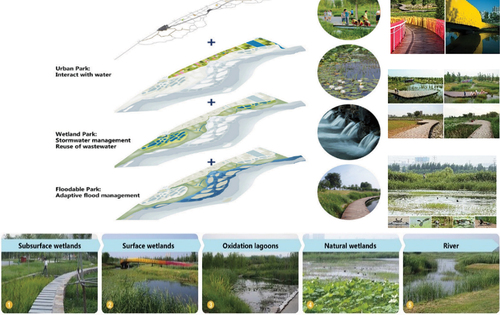
Urban resilience challenge
Challenges ranged from:
How to transform the former industrial site into a sustainable park. In addition to the complex funding.
Managing the brownfield cleanup and excavation of a historical site to coordination with multiple agencies.
The historic importance of the site stems from its use as a maintenance yard for buses and trolleys dating back to 1901.
Partnership and interagency coordination as well as public stakeholders
Project concept
The South LA Wetland Park proves a bold, integrated, and sustainably engineered project approach that can
Capture and treat urban rainwater runoff.
Divert water through a flood control system through constructed wetland system.
Transform a former brownfield site into a rare public park space for the community,
Provide a neighborhood revitalization facility in a historically neglected area.
Create a new neighborhood rejuvenating amenity, see [Citation25].
Resilience Project outcomes
Physical outcome:
Creation of a series of wetlands that filter urban stormwater runoff before it is reintroduced into the area’s water supply [Citation24].
Rainwater management through rainwater collection, storage, and purification. This reduces rainwater flooding.
Mitigating the effects of climate change and the urban heat island effect.
Reduction of carbon sequestration.
Ecological outcome:
Treating 14,000 gallons of rainwater runoff from the 525-acre catchment per day. This is enough ability to treat all runoff during the dry season.
Removing of 100% of oils & greases, 75% of bacteria, 96% of total suspended solids, 41% of nitrates and 34% of phosphorus from rainwater runoff
Planting eighty-eight kinds of trees along the perimeter of the wetland. Helping to sequester 1.82 tons of atmospheric carbon per year.
Reuse of decomposed granite in pedestrian trail along the pond
Sustain natural habitats and connecting the city to nature.
Maintaining wetland pond depths of at least five feet promotes water flow, increases water oxygenation, limits establishment of emerging plants, allows particle deposition, and reduces mosquito breeding will be suppressed.
Social outcome:
Adding cultural value to the community.
Supplying recreational and social activities opportunities for residents and visitors
Providing an outlet for visitors of all ages and various activities
Creating Impressive surrounding recreation trail
Educating visitors about the types of plants, regions, and the wetland treatment process by educational signage.
Financial outcome:
Enhancing the Land Value,
Contributing to increase home value within approximate blocks.
reducing energy consumption on site by using Solar powered lighting.
producing 8,081 kWh of energy annually, which is 66% of the site’s total energy use. saving $1,700 in energy bills annually [Citation25].
The earlier three different showcased above revealed that the constructed wetlands are considered as one of the best natural resilience solutions for managing the urban challenges. As the frame of each case linked to the nature of risks, and physical, ecological, social, financial city’s character.
Constructed wetlands in Egypt (opportunities and challenges)
This technique was used in Egypt to purify water, but it was no longer an agricultural activity. Its benefits were limited to water purification and its use for irrigation, agriculture, and fish farming. The technique was used by the Ministry of Irrigation and the National Water Research Institute in Egypt’s Bahr Al Bakar drainage canal on Lake Manzala, where agricultural wastewater was treated and reused to irrigate crops. There is also another group of lakes and ponds in the Western Desert, created by the natural accumulation of agricultural runoff and the collapse of the Toshka sewer, and which were created as freshwater basins after part of the excess flood water was diverted during the Nile floods [Citation26].
Urban challenges in Egyptian cities
Egyptian cities face many challenges in enhancing their resilience and risks, whether social, economic, technological or natural. Development and prosperity strategies are threatened as following [Citation27]:
Indiscriminate urbanization, because of the non-adherence to urban spatial plans leading to increased pressure on land, institutions, and services.
Lack of infrastructure in some urban areas, while marginalizing the needs of vulnerable groups, particularly low-income populations.
Poorly maintained infrastructure increases the size of natural hazards, such as flooding and urban heat island effects.
Climate change-related disasters affecting urban areas (rising sea levels, storm surge, nonstop rains, heat waves impact, water scarcity and air pollution).
Lack of disaster preparedness, rapid response, and effective coordination as a part of the emergency strategies
Constructed wetlands (Cws) as resilient solutions to urban challenges in Egyptian cities
In Egypt, constructed wetlands (Cws) are a promising solution to a variety of urban and climate problems, including examples: heat island effect, high levels of pollution in Egyptian cities, wastewater management, storm runoff, coastal zone management.
Egypt Cities can be categorized according to their exposure to urban hazards, along with their main characteristics, into: Coastal, Delta and river, Desert cities, see .
Figure 13. South LA Wetland Park Existing situation (stormwater runoff treatment design, currently fully operational park, supplying community recreational possibilities). Source: (Shannon, K., et al., 2016- LPS-CSB- 1041, 2016).

Coastal cities
Cities are found on the Red Sea and Mediterranean coasts and benefit from coastal ecosystem services. At the same time, these cities face threats such as sea level rise, coastal flooding, erosion, and other forms of land subsidence and saltwater intrusion. Constructed wetlands could improve by:
Formation of intermediate buffer zones that protect beaches and coasts from erosion.
Reducing the energy of waves and storm surges
Reducing saltwater intrusion and making use of rainwater.
Delivering more productive, aesthetically pleasing, and resilient solutions.
Delta and river cities
Found along the Nile River, which receive help from fertile soils, but also suffer from seasonal fluctuations in water level, and are often prone to flooding. Constructed wetlands enhance urban resilience by:
Rehabilitation of floodplains of rivers
Performance as a natural sponge to enhance rainwater storage and reduce flood risks in downstream areas.
Reducing surface runoff of rainwater.
Increasing carbon sequestration and reducing pollution levels in these cities.
Restore the balance of the ecosystem.
Increase green spaces or open parks throughout the city and reduce urban heat.
Exploiting endangered lands in the Nile Delta for aquaculture or rice cultivation. It has beneficial effects on the soil.
Enhancing food security.
Desert cities
Found in the eastern and western deserts and the Sinai Peninsula. The difference in the characteristics of the geographical location appears between the desert cities in the eastern desert and Sinai and the oasis cities in the Western Desert. The first is characterized by steep slopes, and it is often vulnerable to flash floods from stormwater, erosion, and landslides. Constructed wetlands enhance urban resilience through:
Restoration of forest cover in high mountain areas to intercept and slow down flood waters.
Collecting the absorbed water and recharging the groundwater level.
Reduce heat island effect.
In Oasis cities in the Western Desert, constructed wetlands enhance urban resilience through:
Creation of green belts in remote areas based on the use of treated wastewater from local communities.
Support the stability of the soil and reduce the movement of sand dunes and thus reduce the impact of dust on the Nile Delta.
Supplying job opportunities for the population, see .
Figure 14. Cities classification in Egypt. Source: Author, adapted from World Bank, 2021. A catalogue of Nature-based solutions for urban resilience. Washington, D.C. World Bank Group.
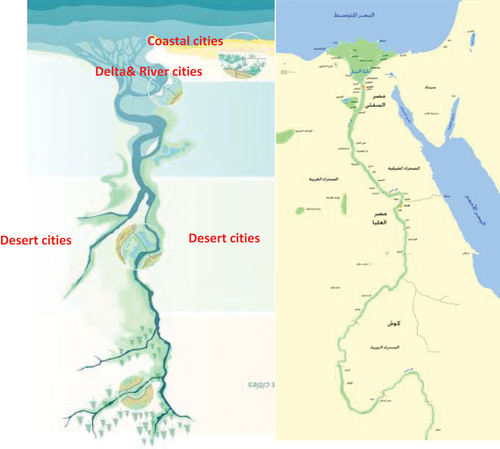
Figure 15. The vertical section proves the potential of integrating constructed wetlands (cws) as nature-based solutions into urban landscapes (coastal, riverine, and desert) to enhance urban resilience and support disaster risk management. Source: Author, adapted from World Bank, 2021. A catalogue of nature-based solutions for urban resilience. Washington, D.C. World Bank Group.
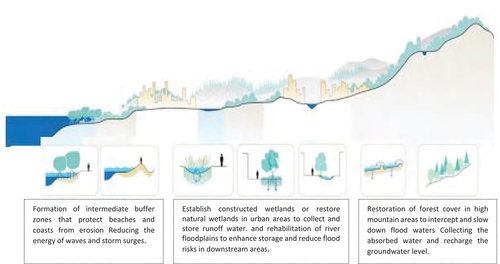
Conclusion, findings, and recommendations
Cities face increasing climate-related challenges. Climate change and urbanization are worsening disaster risks, and these risks hit the poor and vulnerable hardest people. By protecting natural systems and investing in green infrastructure, cities can strengthen their resilience and protect development gains for future generations.
There is growing interest in nature-based solutions (NBS) and harnessing nature for climate resilience around the world. Major international agreements highlight the importance of this NBS as a resilience-building tool and as a resilience system to manage climate change and disaster risks.
Theoretical and analytical studies show that constructed wetlands are a flexible technology, and several benefits can be realized by combining this technology with gray infrastructure.
Physically, it stands for a multifunctional landscape that can be used to address a variety of urban and climate change issues.
Ecologically, they improve water and air quality, energy supply and conservation, promote natural habitats and biodiversity, adapt to specific site conditions, and protect important ecosystems.
Socially, constructed wetlands improve the quality of life of citizens through aesthetically pleasing recreational landscaping that combines green space and water bodies, thereby increasing community connectivity.
Financially, these are sustainable projects that not only use fewer resources but can also generate economic benefits through agriculture, fishing, and other economic activities.
As a conclusion, this study aims research recommends recreating the installation of constructed wetlands (Cws) in Egyptian cities allowing them to use in unusual ways, as well as gray infrastructure that improves the quality of life and enables flexibility in current and urban areas by reproducing the gray infrastructure that makes it possible. We also recommend applying integration between infrastructure and green infrastructure in the Futuristic Egyptian city.
Disclosure statement
No potential conflict of interest was reported by the author(s).
References
- Index, City Resilience. City resilience framework. The Rockefeller Foundation And ARUP. 2014;2:928.
- Patel R, Nosal L. Defining the resilient city. New York: United Nations University Centre for Policy Research; 2016.
- Xianfu L. Building resilient infrastructure for the future. Asian Development Bank Sustainable Development Working Paper Series. 2019;61:4–6.
- Reguero BG, Beck MW, Schmid D, et al. Financing coastal resilience by combining nature-based risk reduction with insurance. Ecological Economics. 2020;169:106487.
- Solutions EN-B. Final report of the horizon 2020 expert group on nature-based solutions and re-naturing cities. 2015 [cite 29 November 2022]. 15–17. Available from: ec.europa.eu/research/environment/pdf/renaturing/nbs.pdf
- Matthews J, Ocampo Dela Cruz E. Integrating nature-based solutions for climate change adaptation and disaster risk management: a practitioner’s guide. Asian Development Bank. 2022;5–7.
- Matthews N, Simmons E, Vigerstol K, et al. Wellspring: source water resilience and climate adaptation. The Nature Conservancy. 2019;9–15. https://www.nature.org/content/dam/tnc/nature/en/documents/Wellspring_FULL_Report_2019.pdf
- Secretariat R. An introduction to the convention on wetlands (previously the ramsar convention manual). In: Ramsar convention secretariat, Gland, Switzerland. 2016. pp. 9–10.
- World Bank. A catalogue of nature-based solutions for urban resilience. The World Bank, Washington, DC. 2021;9–15. http://hdl.handle.net/10986/36507.
- Kennen K, Kirkwood N. Phyto: principles and resources for site remediation and landscape design. London: Routledge; 2015.
- Alikhani S, Nummi P, Ojala A. Urban wetlands: a review on ecological and cultural values. Water. 2021;13(22):3301.
- Stefanakis AI. The role of constructed wetlands as green infrastructure for sustainable urban water management. Sustainability. 2019;11(24):6981.
- Rosli FA, Ern Lee K, Ta Goh C, et al. The use of constructed wetlands in sequestrating carbon: an overview. Nat Environ Poll Technol. 2017;16(3):814–815.
- Helliwell JF, Huang H, Wang S, et al. Social environments for world happiness. World Happiness Report. 2020;2020(1):13–45.
- Van der Duim VR, Henkens RJHG. Wetlands, poverty reduction and sustainable tourism development: opportunities and constraints. Wageningen: Wetlands International; 2007.
- Wood AP, van Halsema GE. Scoping agriculture–wetland interactions: towards a sustainable multiple-response strategy. Vol. 33, Rome, Italy: FAO, Food and Agriculture Organization of the United Nations; 2008.
- Walton WE. Constructed wetlands still produce mosquitoes. Proc Pap Mosq Vector Control Assoc Calif Mon. 2019;87:1–5.
- Ozkan S. AGA khan award for architecture. Arkitektur N 90, no. 2 2008. AKAA, Wadi Hanifa Wetlands, 2008-2010 Cycle, 2020. [cited 2022 November 29 2022]. Available from: https://www.akdn.org/architecture/project/wadi-hanifa-wetlands
- Al-Obaid S, Samraoui B, Thomas J, et al. An overview of wetlands of Saudi Arabia: values, threats, and perspectives. Ambio. 2017;46:98–108.
- Al-Asad M, Yavuz Y. Wadi Hanifa development plan. Riyadh, Saudi Arabia. 2004.
- Weiliu wetland park by Yifang Ecoscape « landscape architecture platform | landezine. [cited: Jan 3, 2023]. Available from: https://landezine.com/weiliu-wetland-park-by-yifang-ecoscape
- Wahid ANA, Haryati Ibrahim P, Hanurhaza Md Jani H. Resilient village: flood mitigation landscape at perkampungan sungai isap, kuantan, pahang. Design Ideals Journal. 2021;3:(2).
- Luan B, Wang X, Jin Y, et al. Collaborative design of site-scale green infrastructure: a case study on the ecological restoration design of weiliu wetland park in xianyang. Landscape Arch Front. 2017;5(5):26+. Gale Academic OneFile.
- PARLAK PÖ, Çiçek Kurdoğlu B. Constructed wetlands: an example of south los angeles wetlands park. Art And Architecture: Theory, Practice And Experience. 2022;31.
- Shannon K, Christina H. South Los Angeles Wetland Park. Landscape Performance Series. Landscape Architecture Foundation. 2016. https://doi.org/10.31353/cs1130
- Ramsar convention — Medwet. (2020). Medwet.org. [cited 2022 Dec 23]. Available from: https://medwet.org/ar/aboutwetlands/ramsarconvention/.
- Hallegatte S, Vogt-Schilb A, Bangalore M, et al. Unbreakable: building the resilience of the poor in the face of natural disasters. Washington, DC:Climate Change and DevelopmentWorld Bank. ©World Bank; 2017. License: CC BY 3.0 IGO. Available from: https://openknowledge.worldbank.org/handle/10986/25335

